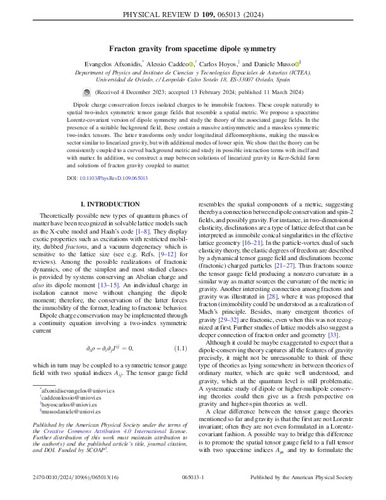Fracton gravity from spacetime dipole symmetry
Autor(es) y otros:
Fecha de publicación:
Versión del editor:
Citación:
Resumen:
Dipole charge conservation forces isolated charges to be immobile fractons. These couple naturally to spatial two-index symmetric tensor gauge fields that resemble a spatial metric. We propose a spacetime Lorentz-covariant version of dipole symmetry and study the theory of the associated gauge fields. In the presence of a suitable background field, these contain a massive antisymmetric and a massless symmetric two-index tensors. The latter transforms only under longitudinal diffeomorphisms, making the massless sector similar to linearized gravity, but with additional modes of lower spin. We show that the theory can be consistently coupled to a curved background metric and study its possible interaction terms with itself and with matter. In addition, we construct a map between solutions of linearized gravity in Kerr-Schild form and solutions of fracton gravity coupled to matter.
Dipole charge conservation forces isolated charges to be immobile fractons. These couple naturally to spatial two-index symmetric tensor gauge fields that resemble a spatial metric. We propose a spacetime Lorentz-covariant version of dipole symmetry and study the theory of the associated gauge fields. In the presence of a suitable background field, these contain a massive antisymmetric and a massless symmetric two-index tensors. The latter transforms only under longitudinal diffeomorphisms, making the massless sector similar to linearized gravity, but with additional modes of lower spin. We show that the theory can be consistently coupled to a curved background metric and study its possible interaction terms with itself and with matter. In addition, we construct a map between solutions of linearized gravity in Kerr-Schild form and solutions of fracton gravity coupled to matter.
ISSN:
Ficheros en el ítem





